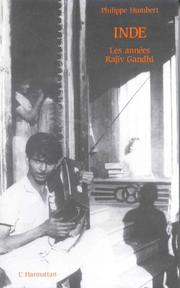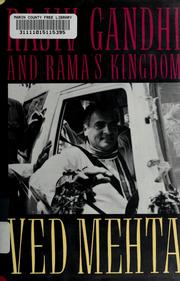| Listing 1 - 3 of 3 |
Sort by
|

ISBN: 2738408699 9782738408693 Year: 1990 Publisher: Paris : L'Harmattan,
Abstract | Keywords | Export | Availability | Bookmark
 Loading...
Loading...Choose an application
- Reference Manager
- EndNote
- RefWorks (Direct export to RefWorks)
Gandhi, Rajiv, --- India --- Inde --- Politics and government --- Politique et gouvernement --- Gandhi, Rajiv --- India - Politics and government - 1977 --- -Gandhi, Rajiv,

ISBN: 0300060386 Year: 1994 Publisher: New haven Yale University Press
Abstract | Keywords | Export | Availability | Bookmark
 Loading...
Loading...Choose an application
- Reference Manager
- EndNote
- RefWorks (Direct export to RefWorks)
Gandhi,Rajiv --- Gandhi, Rajiv --- Mehta, Ved --- India --- Politics and government --- -Gandhi,Rajiv --- -India --- 1977 --- -India - Politics and government - 1977 --- -India - Politics and government - 1977-
Book
ISBN: 1400844428 Year: 2021 Publisher: Princeton : Baltimore, Md. : Princeton University Press, Project MUSE,
Abstract | Keywords | Export | Availability | Bookmark
 Loading...
Loading...Choose an application
- Reference Manager
- EndNote
- RefWorks (Direct export to RefWorks)
For many centuries, Hindus have taken it for granted that the religious images they place in temples and home shrines for purposes of worship are alive. Hindu priests bring them to life through a complex ritual "establishment" that invokes the god or goddess into material support. Priests and devotees then maintain the enlivened image as a divine person through ongoing liturgical activity: they must awaken it in the morning, bathe it, dress it, feed it, entertain it, praise it, and eventually put it to bed at night. In this linked series of case studies of Hindu religious objects, Richard Davis argues that in some sense these believers are correct: through ongoing interactions with humans, religious objects are brought to life.Davis draws largely on reader-response literary theory and anthropological approaches to the study of objects in society in order to trace the biographies of Indian religious images over many centuries. He shows that Hindu priests and worshipers are not the only ones to enliven images. Bringing with them differing religious assumptions, political agendas, and economic motivations, others may animate the very same objects as icons of sovereignty, as polytheistic "idols," as "devils," as potentially lucrative commodities, as objects of sculptural art, or as symbols for a whole range of new meanings never foreseen by the images' makers or original worshipers.
Art and anthropology --- Hindu gods in art. --- Hindu sculpture. --- Abraham. --- Alpers, Svetlana. --- Bahmani Sultanate. --- Banks, Joseph. --- Bonaventure. --- British Museum. --- Delhi Sultanate. --- Esalam bronzes. --- Everest Art Gallery. --- Festival of India. --- Gandhi, Rajiv. --- Gangas of Orissa. --- Hedges, William. --- Hussain, G. Magbool. --- Jayalalitha. --- Kampana. --- Kampili kingdom. --- Mecca. --- Mughals. --- Place, Lionel. --- Sambandhar. --- Skelton, Robert. --- Tirupati. --- art market. --- biography. --- cultural property. --- dispensation. --- idols. --- labels. --- navakalevara. --- taxonomic shift. --- temple Hinduism.
| Listing 1 - 3 of 3 |
Sort by
|

 Search
Search Feedback
Feedback About
About Help
Help News
News